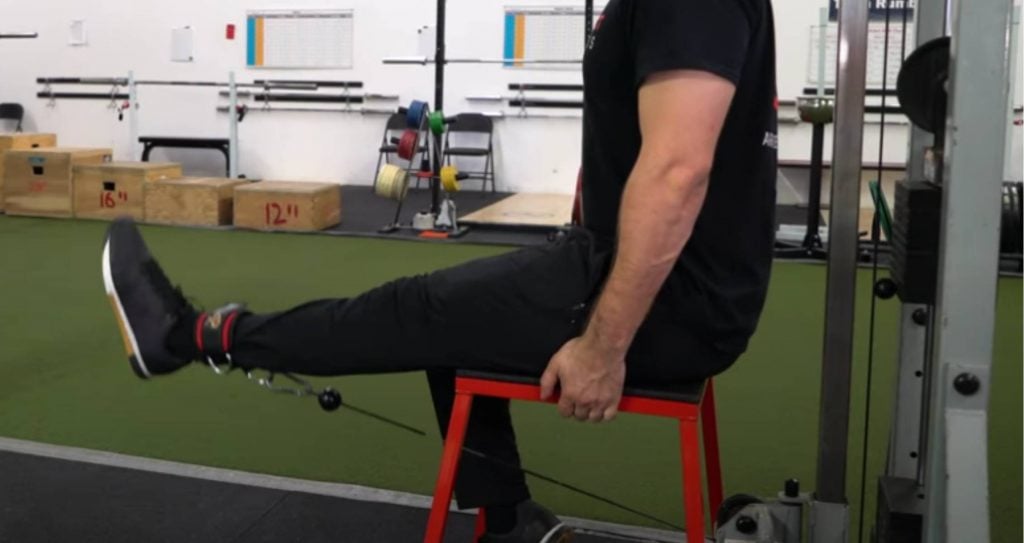Cable leg extensions add variety to your leg workout and engage the quads from a different angle.
Leg workouts are crucial, regardless of your fitness goals. However, it can be frustrating when you arrive at the gym only to find the machines you need for your leg day routine are occupied. That’s where exercises like the cable leg extension come in handy, providing a convenient alternative for targeting your quads.
Leg extensions are one of the best ways to isolate and build your quads for stronger legs (1). This exercise is usually done on a leg extension machine, but you can do it with free weights like dumbbells or kettlebells. For those on the go, resistance bands can also be useful when you aren’t close to any gyms or at home.
For this exercise guide, we’ll share how to use the cable machine for a leg extension. You can do a seated or standing variation, but we’ll look at seated cable leg extensions for this guide. We also share this routine’s benefits and other cable machine alternatives.
Technique and Muscles Worked
The cable leg extension is an isolation exercise that targets and builds the quads. It does this by extending the knees to contract them. As a result, this exercise also reinforces your knee extension, thereby improving the mobility of your lower body.
You need the cable machine, a bench, and ankle straps for a cable leg extension. Below is a step-by-step guide on how to do cable leg extension.
- Set the cable machine at shin level, then attach an ankle strap.
- Place a bench next to the machine such that you can easily fit into your ankle strap.
- Sit on the bench, wear the ankle strap, and bend your knees. This is your starting position.
- Extend your legs forward and then upwards. Pause at the top.
- Lower your leg and return to the starting position to complete the rep.
- Repeat for as many reps as you desire.
- Switch legs and then repeat steps three to six.
Benefits
Apart from the general benefits of exercising and doing resistance training, cable leg extensions have specific advantages. Below are some of the reasons why you should do this exercise.
Isolates the Quads Effectively
Focusing on your quads and other leg muscles can be hard to do with compound exercises. The cable leg extension is an isolation exercise that helps you target and work on your quads. As a result, you can get them larger and stronger.
Variety
The cable leg extension works on your quad muscles from an angle different from regular leg extensions. This is important if you have hit a plateau and your body is used to other exercises. Research shows that variety is one of the ways to break out of a plateau and prevent training monotony (2).
More Volume For the Quads
Since your quad muscles are composed of four muscles, other muscles often get fatigued before them. This limits how much volume you can use to train. Isolating your quads with cable leg extensions adds more reps to your quadriceps, leading to muscle hypertrophy.
Find & Fix Imbalances
The cable leg extension is a unilateral exercise. Since you’ll be training each leg separately, you can easily find any imbalances in strength between them. This exercise can also fix those imbalances by training your weak leg for a bit longer and heavier.
Constant Resistance
When using a cable machine, your resistance is constant throughout your range of motion. This leads to your muscles spending more time under tension. Research shows that a more extended time under tension leads to more muscle growth (3).
Cable Leg Extension Alternatives
Cable leg extensions are an excellent exercise. However, they’re not the only way to train your leg muscles using the cable machine. Below are some other fantastic leg builders that you can try out.
Cable Squats
Cable squats are an excellent alternative to the regular barbell squat. They work the same muscles while remaining back-friendly, as they won’t put all the weight on your back to compress your spine. This exercise also recruits your abs and arms, but your legs are where you’ll feel its effect.
Cable Romanian Deadlifts
Cable Romanian Deadlifts engage your posterior chain — glutes, hamstrings, and lower back. This variation is excellent for those with lower back pain since it doesn’t put too much pressure on your back as the regular Romanian deadlift.
Cable Reverse Lunges
Cable reverse lunges also work on your glutes, quads, adductors, and hamstrings. This routine is also great for your coordination and balance. Cable reverse lunges put less strain on your knees because of the backward movement.
FAQs
What does cable leg extension work?
The cable leg extension works on your legs. This exercise explicitly isolates your quads.
Are cable leg extensions effective?
Yes, cable leg extensions are an effective way to train your legs. The machine’s constant resistance to your quads helps promote muscle hypertrophy and growth.
How do you do a leg extension with cable?
You need a bench and an ankle strap attachment to do leg extensions with the cable machine. For a more detailed direction, check the guide above.
Follow us on Instagram, Facebook, and Twitter for more exercise guides!
References
- Varović, D., Žganjer, K., Vuk, S., & Schoenfeld, B. J. (2021). Drop-Set Training Elicits Differential Increases in Non-Uniform Hypertrophy of the Quadriceps in Leg Extension Exercise. Sports (Basel, Switzerland), 9(9), 119. https://doi.org/10.3390/sports9090119
- Krzysztofik, M., Wilk, M., Wojdała, G., & Gołaś, A. (2019). Maximizing Muscle Hypertrophy: A Systematic Review of Advanced Resistance Training Techniques and Methods. International journal of environmental research and public health, 16(24), 4897. https://doi.org/10.3390/ijerph16244897
- Mang, Z. A., Ducharme, J. B., Mermier, C., Kravitz, L., de Castro Magalhaes, F., & Amorim, F. (2022). Aerobic Adaptations to Resistance Training: The Role of Time under Tension. International journal of sports medicine, 43(10), 829–839. https://doi.org/10.1055/a-1664-8701








